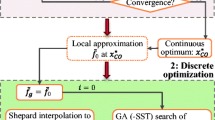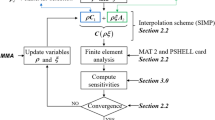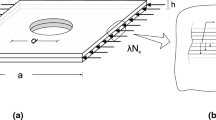Abstract
This work presents a new strategy for dealing with blending requirements in the composite structures design. Firstly, new analytical expressions of blending constraints, in the polar parameters space, are derived. Secondly, a dedicated numerical strategy for the recovery of blended stacking sequences is presented. The proposed approach is implemented in the framework of the multi-scale two-level optimisation strategy (MS2LOS) for composite laminates design. The theoretical aspects of this work are supported by the application of the proposed methodology to a numerical benchmark taken from the literature. The results obtained by means of the MS2LOS based on the polar formalism outperform those reported in the literature.









Similar content being viewed by others
Notes
Read: SSq is a function of SSp and Nq − Np new orientations. Alike expressions in the following mean similar relationships
Abbreviations
- BCs:
-
Boundary conditions
- CLT:
-
Classic laminate theory
- CNLPP:
-
Constrained non-linear Programming problem
- DOFs:
-
Degrees of freedom
- FE:
-
Finite element
- FSDT:
-
First-order shear deformation theory
- FLP:
-
First-level problem
- GA:
-
Genetic algorithm
- LPs:
-
Lamination parameters
- MICNLPP:
-
Mixed-integer constrained non-linear programming problem
- MS2LOS:
-
Multi-scale two-level optimisation strategy
- PPs:
-
Polar parameters
- RSS:
-
Recovery stacking sequence
- SR:
-
Stiffness recovery
- SS:
-
Stacking sequence
- SLP:
-
Second-level problem
- SST:
-
Stacking sequence table
- UNLPP:
-
Unconstrained non-linear programming problem
- ξ :
-
Design variables vector
- 𝜃 :
-
Orientation
- Φ :
-
Objective function
- {ρ 0, ρ 0K, ρ 1, ϕ 1}:
-
Dimensionless PPs
- A(A ∗):
-
(normalised) Membrane stiffness tensor
- B(B ∗):
-
(normalised) Membrane/bending coupling stiffness tensor
- \({\mathcal{B}}\) :
-
Blending operator
- C(C ∗):
-
(normalised) Homogeneity stiffness tensor
- D(D ∗):
-
(normalised) Bending stiffness tensor
- H(H ∗):
-
(normalised) Out-of-plane shear stiffness tensor
- h :
-
Laminate thickness
- K lam :
-
Stiffness tensor of a laminate
- N:
-
number of plies
- \({\mathcal{M}}\) :
-
Modulus to normalise coupling and homogeneity tensors
- \(\mathcal {N}\) :
-
Set of ply indices not interested by blending
- n 0 :
-
Dimensionless number of plies
- \(\mathcal {R}\) :
-
Residual
- \({\mathcal{R}}\) :
-
Residual for a laminate
- {T, R, Φ}:
-
PPs of the out-of-plane shear stiffness tensor of the base ply
- {T 0, T 1, R 0, R 1, Φ 0, Φ 1}:
-
PPs of the base ply reduced stiffness tensor
References
Adams D B, Watson L T, Gürdal Z, Anderson-Cook C M (2004) Genetic algorithm optimization and blending of composite laminates by locally reducing laminate thickness. Adv Eng Softw 35(1):35–43. https://doi.org/10.1016/j.advengsoft.2003.09.001
Allaire G, Delgado G (2016) Stacking sequence and shape optimization of laminated composite plates via a level-set method. Journal of the Mechanics and Physics of Solids 97:168–196. https://doi.org/10.1016/j.jmps.2016.06.014
Bordogna MT, Macquart T, Bettebghor D, Breuker RD (2016) Aeroelastic optimization of variable stiffness composite wing with blending constraints. In: 17th AIAA/ISSMO Multidisciplinary Analysis and Optimization Conference, American Institute of Aeronautics and Astronautics https://doi.org/10.2514/6.2016-4122
Cairns D, Mandell J, Scott M, Maccagnano J (1999) Design and manufacturing considerations for ply drops in composite structures. Composites Part B: Engineering 30(5):523–534. https://doi.org/10.1016/s1359-8368(98)00043-2
Catapano A, Montemurro M (2014a) A multi-scale approach for the optimum design of sandwich plates with honeycomb core. Part i: homogenisation of core properties. Compos Struct 118:664–676. https://doi.org/10.1016/j.compstruct.2014.07.057
Catapano A, Montemurro M (2014b) A multi-scale approach for the optimum design of sandwich plates with honeycomb core. Part II: the optimisation strategy. Compos Struct 118:677–690. https://doi.org/10.1016/j.compstruct.2014.07.058
Costa G, Montemurro M, Pailhės J (2017) A 2D topology optimisation algorithm in NURBS framework with geometric constraints. Int J Mech Mater Des 14(4):669–696. https://doi.org/10.1007/s10999-017-9396-z
Costa G, Montemurro M, Pailhès J (2019) NURBS hyper-surfaces for 3D topology optimization problems. Mechanics of Advanced Materials and Structures pp 1–20, https://doi.org/10.1080/15376494.2019.1582826
Dorigo M, Birattari M, Stutzle T (2006) Ant colony optimization. IEEE Comput Intell Mag 1(4):28–39. https://doi.org/10.1109/mci.2006.329691
Ghiasi H, Pasini D, Lessard L (2009) Optimum stacking sequence design of composite materials part i: Constant stiffness design. Compos Struct 90(1):1–11. https://doi.org/10.1016/j.compstruct.2009.01.006
Ghiasi H, Fayazbakhsh K, Pasini D, Lessard L (2010) Optimum stacking sequence design of composite materials part II: Variable stiffness design. Compos Struct 93 (1):1–13. https://doi.org/10.1016/j.compstruct.2010.06.001
Ijsselmuiden ST, Abdalla MM, Seresta O, Gürdal Z (2009) Multi-step blended stacking sequence design of panel assemblies with buckling constraints. Composites Part B: Engineering 40(4):329–336. https://doi.org/10.1016/j.compositesb.2008.12.002
Irisarri FX, Lasseigne A, Leroy FH, Riche RL (2014) Optimal design of laminated composite structures with ply drops using stacking sequence tables. Compos Struct 107:559–569. https://doi.org/10.1016/j.compstruct.2013.08.030
Jones R (1975) Mechanics of composite materials. Materials science and engineering series, Taylor & Francis
Kandil N, Verchery G (1988) New methods of design for stacking sequences of laminates. Computer aided design in composite material technology, 243–257
Kristinsdottir B P, Zabinsky Z B, Tuttle M E, Neogi S (2001) Optimal design of large composite panels with varying loads. Compos Struct 51(1):93–102. https://doi.org/10.1016/s0263-8223(00)00128-8
Liu B, Haftka R, Akgün M (2000) Two-level composite wing structural optimization using response surfaces. Struct Multidisc Optim 20(2):87–96. https://doi.org/10.1007/s001580050140
Liu D, Toroporov V V, Querin O M, Barton D C (2011) Bilevel optimization of blended composite wing panels. J Aircr 48(1):107–118. https://doi.org/10.2514/1.c000261
Macquart T, Bordogna M T, Lancelot P, Breuker R D (2016) Derivation and application of blending constraints in lamination parameter space for composite optimisation. Compos Struct 135:224–235. https://doi.org/10.1016/j.compstruct.2015.09.016
Montemurro M (2015a) An extension of the polar method to the first-order shear deformation theory of laminates. Compos Struct 127:328–339. https://doi.org/10.1016/j.compstruct.2015.03.025
Montemurro M (2015b) Corrigendum to an extension of the polar method to the first-order shear deformation theory of laminates. Compos Struct 131:1143–1144. https://doi.org/10.1016/j.compstruct.2015.06.002
Montemurro M (2015c) The polar analysis of the third-order shear deformation theory of laminates. Compos Struct 131:775–789. https://doi.org/10.1016/j.compstruct.2015.06.016
Montemurro M, Catapano A (2016) A new paradigm for the optimum design of variable angle tow laminates. In: Variational analysis and aerospace engineering. https://doi.org/10.1007/978-3-319-45680-5_14. Springer International Publishing, pp 375–400
Montemurro M, Catapano A (2017) On the effective integration of manufacturability constraints within the multi-scale methodology for designing variable angle-tow laminates. Compos Struct 161:145–159. https://doi.org/10.1016/j.compstruct.2016.11.018
Montemurro M, Catapano A (2019) A general B-Spline surfaces theoretical framework for optimisation of variable angle-tow laminates. Compos Struct 209:561–578. https://doi.org/10.1016/j.compstruct.2018.10.094
Montemurro M, Vincenti A, Vannucci P (2012a) Design of the elastic properties of laminates with a minimum number of plies. Mech Compos Mater 48(4):369–390. https://doi.org/10.1007/s11029-012-9284-4
Montemurro M, Vincenti A, Vannucci P (2012b) A two-level procedure for the global optimum design of composite modular structures–application to the design of an aircraft wing. J Optim Theory Appl 155 (1):24–53. https://doi.org/10.1007/s10957-012-0070-1
Montemurro M, Vincenti A, Vannucci P (2012c) A two-level procedure for the global optimum design of composite modular structures–application to the design of an aircraft wing. J Optim Theory Appl 155 (1):1–23. https://doi.org/10.1007/s10957-012-0067-9
Montemurro M, Catapano A, Doroszewski D (2016) A multi-scale approach for the simultaneous shape and material optimisation of sandwich panels with cellular core. Composites Part B: Engineering 91:458–472. https://doi.org/10.1016/j.compositesb.2016.01.030
Montemurro M, Pagani A, Fiordilino G A, Pailhės J, Carrera E (2018) A general multi-scale two-level optimisation strategy for designing composite stiffened panels. Compos Struct 201:968–979. https://doi.org/10.1016/j.compstruct.2018.06.119
Montemurro M, Izzi M I, El-Yagoubi J, Fanteria D (2019) Least-weight composite plates with unconventional stacking sequences: Design, analysis and experiments. J Compos Mater 53(16):2209–2227. https://doi.org/10.1177/0021998318824783
Ntourmas G, Ozcan E, Chronopoulos D, Glock F, Daoud F (2019) Towards a streamlined stacking sequence optimisation methodology for blended composite aircraft structures. Proceedings of the 8th European conference for aeronautics and space sciences. Madrid, Spain, 1–4 July 2019. https://doi.org/10.13009/EUCASS2019-632
Panettieri E, Montemurro M, Catapano A (2019) Blending constraints for composite laminates in polar parameters space. Composites Part B: Engineering 168:448–457. https://doi.org/10.1016/j.compositesb.2019.03.040
Picchi Scardaoni M, Montemurro M (2020) A general global-local modelling framework for the deterministic optimisation of composite structures. Struct Multidisc Optim https://doi.org/10.1007/s00158-020-02586-4
Reddy J N (2003) Mechanics of laminated composite plates and shells: Theory and analysis, 2nd edn. CRC Press, Boca Raton
Schlüter M, Gerdts M (2009) The oracle penalty method. J Glob Optim 47(2):293–325. https://doi.org/10.1007/s10898-009-9477-0
Schlüter M, Egea JA, Banga JR (2009) Extended ant colony optimization for non-convex mixed integer nonlinear programming. Computers & Operations Research 36(7):2217–2229. https://doi.org/10.1016/j.cor.2008.08.015
Schlüter M, Gerdts M, Rückmann JJ (2012) A numerical study of MIDACO on 100 MINLP benchmarks. Optimization 61(7):873–900. https://doi.org/10.1080/02331934.2012.668545
Schlueter M (2018) Midaco solver user guide. 6th edn.
Seresta O, Gürdal Z, Adams DB, Watson LT (2007) Optimal design of composite wing structures with blended laminates. Composites Part B: Engineering 38(4):469–480. https://doi.org/10.1016/j.compositesb.2006.08.005
Soremekun G, Gürdal Z, Kassapoglou C, Toni D (2002) Stacking sequence blending of multiple composite laminates using genetic algorithms. Composite Structures 56(1):53–62. https://doi.org/10.1016/s0263-8223(01)00185-4
The MathWork Inc (2011) Optimization toolbox user’s guide
Vannucci P (2012) A note on the elastic and geometric bounds for composite laminates. J Elast 112(2):199–215. https://doi.org/10.1007/s10659-012-9406-1
Vannucci P (2017) Anisotropic elasticity. Springer-Verlag GmbH, https://doi.org/10.1007/978-981-10-5439-6
Verchery G (1982) Les invariants des tenseurs d’ordre 4 du type de l’élasticité. In: Mechanical Behavior of Anisotropic Solids / Comportment Méchanique des Solides Anisotropes, Springer Netherlands, pp 93–104
Zein S, Colson B, Grihon S (2011) A primal-dual backtracking optimization method for blended composite structures. Struct Multidisc Optim 45(5):669–680. https://doi.org/10.1007/s00158-011-0716-x
Funding
This paper presents part of the activities carried out within the research project PARSIFAL (“PrandtlPlane ARchitecture for the Sustainable Improvement of Future AirpLanes”), which has been funded by the European Union under the Horizon 2020 Research and Innovation Program (Grant Agreement No. 723149).
Author information
Authors and Affiliations
Corresponding author
Ethics declarations
Conflict of interest
The authors declare that they have no conflict of interest.
Additional information
Responsible Editor: Ming Zhou
Replication of results
Authors are confident that the results can be reproduced. Readers interested in more details are encouraged to contact the corresponding author via email.
Publisher’s note
Springer Nature remains neutral with regard to jurisdictional claims in published maps and institutional affiliations.
Appendices
Appendix 1. A note on the square of the sum of n terms
Consider the square of the sum of terms \(a_{1}, a_{2}, \dots ,a_{n}\), \(n\in \mathbb {N}\). Hence, it easy to see that
where the distributivity property of sum and product operators has been used.
The number of the double-product terms is equal to
If a n-term sequence {ak} has indices k progressively taking values in an arbitrary, but ordered, set of n natural numbers, say \(\mathcal {A}\), the square of the sum of the sequence elements can be written as
Of course, the result of (A1.2) still holds.
Appendix 2. Study of B ∗ = O for blending constraints
Uncoupling condition on laminates is B∗ = O, which can be stated as follows:
Considering (6) and (9), (A2.1) may be expressed as:
As already done in Section 5, consider two laminates denoted with labels p and q, such that, without loss of generality, Np > Nq. Writing (A2.2) and (A2.3) for the two laminates, subtracting member-by-member, taking the square of both members, one obtains:
and
Consider, for the sake of simplicity, the right-hand side of (A2.4) (similar considerations hold for (A2.5). It can be expressed as:
Considering Appendix 1 and the elementary trigonometric identity \(\cos \limits \alpha \cos \limits \beta + \sin \limits \alpha \sin \limits \beta = \cos \limits (\alpha - \beta )\), the sum c1 + c4 gives:
In a complete similar manner, the sum c2 + c5 simplifies to
The sum c3 + c6 can be rewritten as (using the distributivity property of sum and product operators and the aforementioned trigonometric identity)
Assembling (A2.7), (A2.8) and (A2.9), (A2.6) simplifies to:
It is simple to see that
since terms of the form \(\left ({\mathcal{B}}(\cdot ) - \cdot \right )\) are always non-negative, because of property (b) of Def. 2.2.
Consider the particular case for which \({\mathcal{B}}(k)=k\); it follows that \(\mathcal {N}=\{i \ | \ N_{q}+1\leq i\leq N_{p}\}\). Equation (A2.11) simplifies to:
The final blending constraints, for the considered particular case, read:
Figure 10 shows, for the reference laminate of Section 5, that condition of (20) is stricter than the one expressed by (A2.13). Even though CB is not the sharpest upper bound of (A2.11), the fact that the condition B∗ = O does not introduce further constraints on PPs can be inferred. In fact, if there exists another estimate C > CB (for which (A2.13) would read \(g_{\text {blend}-i}^{C} \leq 0\), i = 0, 1, with a clear meaning of notation), the feasible domain can only be larger than the (green) one in Fig. 10.
The result may be due to the fact that increasing separately the “angle terms”, as done in (A2.11), and the “arrangement terms”, as done in (A2.12), is too rude. Indeed, a coupling between the aforementioned terms exists, which makes finding a good estimate of (A2.10) a cumbersome, probably impossible, task.
Rights and permissions
About this article
Cite this article
Picchi Scardaoni, M., Montemurro, M., Panettieri, E. et al. New blending constraints and a stack-recovery strategy for the multi-scale design of composite laminates. Struct Multidisc Optim 63, 741–766 (2021). https://doi.org/10.1007/s00158-020-02725-x
Received:
Revised:
Accepted:
Published:
Issue Date:
DOI: https://doi.org/10.1007/s00158-020-02725-x





